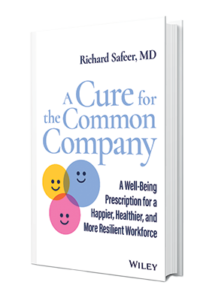Perhaps the greatest predictor of successfully adopting and sustaining a healthy lifestyle habit is whether that same healthy habit is practiced by a friend, family member, or close co-worker. When aiming to lose weight, joining a program with three friends will help you lose 33% more weight and keep it off longer than attempting to lose the weight alone.[1] But how do we use that reality as we try to build well-workplace cultures?
Our best work friends and immediate co-workers are extremely influential in the choices we make every day. Teaching employees how to support their peers is a critical element of advancing healthy norms and a positive social climate. Frankly, we’re all pretty good at not supporting the best habits or behaviors, or even going so far as to knock people down for trying or to feel cynical about support when it’s offered. Companies that teach employees how to be effectively supportive, though, see much stronger cultures of health and have an easier time building new norms. If you’re struggling to meet your health and well-being goals, consider whether your coworkers are helping or hurting your effort.
How can we leverage the power of peer support to mobilize health-promoting workplace cultures?
To provide effective peer support, we must practice eight interpersonal skills:
Listen…Sounds simple because it is. If you can’t master this skill, it will be difficult for you to be good at the other seven skills.
- Help set healthy lifestyle goals. Goals are most impactful when we arrive at them ourselves. Listen and ask questions to help your peer formulate their goals. Don’t tell them what to do!
- Find good role models for your team members. An effective role model is someone who has successfully achieved a similar goal under comparable circumstances. Such a role model can share lessons learned through personal experience.
- Help your peer eliminate barriers to lifestyle change. Whether it be resources, time, energy, or some other factor, take the time to understand your peer’s challenges and think creatively about how you can help them overcome them.
- Help a peer locate resources. Physical and social environments can make or break our efforts to make lifestyle changes. Help identify the people and places that make it as easy as possible to make the healthy choice.
- Help a peer get back on track. When setbacks occur, help your peer quickly get back on track. Set goals for challenging times (i.e., holidays, travel) and remind them setbacks do not diminish past successes. Urge them to review their resources, the reason why they are trying to achieve a healthier place and what they can do differently the next time a similar speedbump comes up on their path.
- Peer support. This requires a high level of mutual trust and openness. Establish trust through confidentiality, context, communication, commitment, and competency.
- Celebrate progress. Don’t wait until the goal is reached. Every step counts. Celebrating progress is helpful for staying on track.
- Positive feedback is an important reward.
The next time a peer is looking to pursue a healthy habit, try putting these skills to work. By applying these skills, you will be supporting the adoption and maintenance of health-promoting behaviors. Your peer is likely to help you in return!
To make peer support readily available, some companies work to create opportunities, such as buddy systems, groups devoted to certain goals, online tools for finding co-workers who are pursuing similar goals, and more. These types of frameworks make peer support safe—easier to offer and easier to receive.
Sometimes, the work of peer support goes beyond helpful to critical. Take Union Pacific’s culture of health, which unsurprisingly is heavily focused on safety and employee promotion. A railroad that hauls freight can see all sorts of injuries and accidents if everybody isn’t paying attention, especially given that operations take place across many thousands of miles throughout the western US. So, UP relies heavily on peer support. First, their “Total Safety Culture” is employee-driven, not management driven. Second, every employee takes the following “Courage to Care” pledge:
I have the courage to care. Worn with a lion’s pride, it means those I work with will have my back, and I will have theirs. I pledge to shield myself and my team from harm. I will take action to keep them safe, by fixing an unsafe situation, addressing an unsafe behavior, or stopping the line. In turn, I will have the courage to accept the same actions from my coworkers, who care enough to correct my path. We wear this badge out of respect for each other and those who have gone before us. On my watch, we will all go home safe to our families every day.[2]
UP does more than ask for the pledge, though. They train employees on how to directly but positively address any behavior that seems unsafe with their peers and encourage employees to recognize their peers for high-safety behaviors. The result? Less than one injury for every 200,000 employee work hours.[3]
Has your workplace created a peer support strategy that you think works? Tell me about your experience by leaving a comment below. If you approve, I might use your story in one of my future presentations!
[1] R.R. Wing and R.W. Jeffery, “Benefits of Recruiting Participants with Friends and Increasing Social Support for Weight Loss and Maintenance,” Journal of Consulting and Clinical Psychology, 1999; 67:132-38.
[2] Union Pacific: Employee Safety, available at https://www.up.com/aboutup/community/safety/employee/.
[3] https://www.up.com/cs/groups/public/@uprr/@corprel/documents/up_pdf_nativedocs/pdf_up_2020_build_america_rep.pdf


